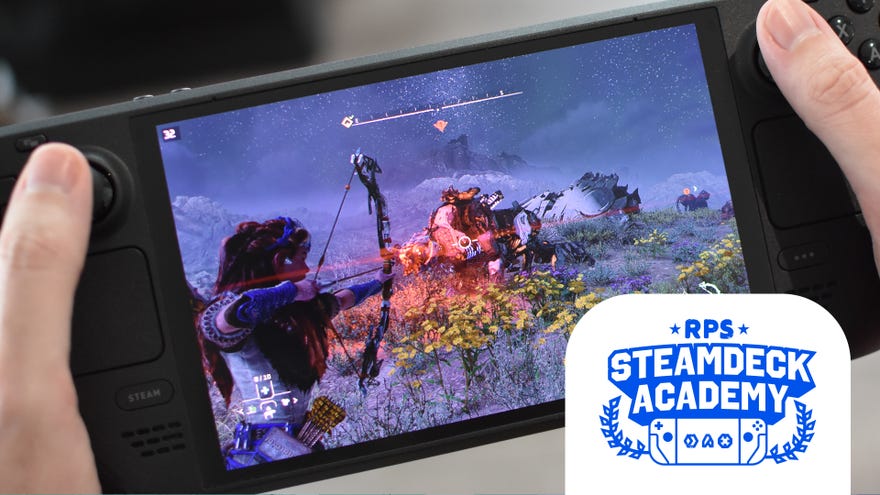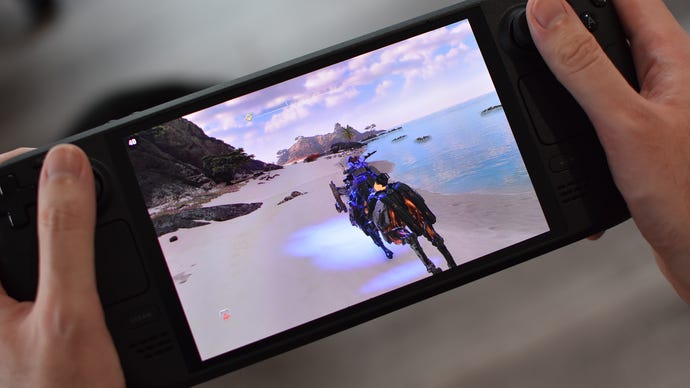HomeHardwareFeatures
Horizon Forbidden West makes a fine Steam Deck game, if you can make room for itWest laid plans
West laid plans
Image credit:Rock Paper Shotgun
Image credit:Rock Paper Shotgun

Not every March-released, fantastical action-RPGwill fall to bits on theSteam Deck.Horizon Forbidden West: Complete Editionsucceeds whereDragon’s Dogma 2 spluttered, quietly yet capably adapting to handheld hardware. Keeping performance up requires a fair bit of fine-tuning the graphics settings, and a girthsome install size might trouble the internal drives of smaller models, but otherwise, Forbidden West is just as portable-friendly asHorizon Zero Dawn. And that’s still one of thebest Steam Deck gamesaround.
Image credit:Rock Paper Shotgun

Steam Deck Academybrings together all our guides and explainers on getting the most out of your Steam Deck, no student loans or sweaty dormitories required.
Seriously though, unless you’re rocking a 512GB Steam Deck (or one of the fancy-scmancy 1TBSteam Deck OLEDs), this one’s going straight to themicroSD card. With the Complete Edition packing in both the base game and the Burning Shores expansion, Forbidden West asks for a heaving 150GB of install space in its system requirements and ends up eating 124GB once complete). That’s a lot of mecha-dinos and ginger braid textures, for sure.
Image credit:Rock Paper Shotgun

On the topic of performance, I’ve worked out a settings guide below that will stay acceptably close to 30fps without absolutely gutting the game’s eye-catching visuals. You may still see some momentary dips below that, but also some smoother stretches of 35-40fps, which isn’t bad going for a game of Forbidden West’s production standards. Also, while it’s more demanding that Zero Dawn graphically, it won’t drain yourSteam Deck’s batterywith much more gusto. I could play Forbidden West for 2h 13m on a Steam Deck OLED and 1h 26m on a classic 512GB Deck, barely down from Zero Dawn’s respective 2h 15m and 1h 31m. As always, these results were recorded with both speaker volume and screen brightness at 50%, but otherwise a ‘normal’ set of settings. You could therefore stretch out your uptime with lower brightness, a lowered refresh rate limit, or flight mode.
As a former PS5 exclusive, it should also go with saying that Forbidden West plays well on gamepad controls. Guerilla’s default mapping is a work of UX art, fitting dozens of actions and inputs onto a limited set of face buttons and analogue sticks in a way that still feels natural and comfortable.
Otherwise, and not forgetting how much storage space it needs, Horizon Forbidden West looks and feels like another great Deck game. Valve haven’t finished putting it through their compatibility rating tests at the time of writing, but a full Verified rating seems likely, and if it doesn’t get at least Playable I’ll break apart myLego Tallneckand stamp on all the bricks.
Image credit:Rock Paper Shotgun

Horizon Forbidden West: best settings for the Steam Deck
Regular readers of our performance analyses will know I’m fond of using graphics presets as a base, then applying just five or six high-impact settings changes to boost performance without kneecapping the visuals. The approach suits Forbidden West on most modern desktop hardware, but faced with the sheer modesty of the Steam Deck, an even more piecemeal approach is necessary.
Here’s what I’ve settled on, combining elements of the Medium, Low and Very Low presets and adding FSR 2.2 upscaling for even more speed:
Dynamic resolution scaling works well here, just as it works well on low-end desktop hardware. Matched up with FSR 2.2, it effectively swaps between Quality, Balanced, and Performance upscaling modes on the fly, depending on how much help the game needs to reach 30fps at a given moment. In my experience, this is a more refined alternative to simply having one of these modes enabled performantly. Quality, for example, might look better during quiet moments, but can’t aid performance enough in busy settlements. Performance mode, on the other hand, will do a better job of preventing those framerate drops, but might unnecessarily reduce image quality in those more easygoing areas. Dynamic resolution scaling provides the best of both worlds.
I’d also recommend using Medium textures. Low and Very Low aren’t actually that much faster, but they do reduce visual quality to a far more noticeable degree than, say, the drop from High to Medium. SSAO and screen space reflections also contribute a lot to detail richness, without providing a significant speed boost when disabled, so keep those on as well.